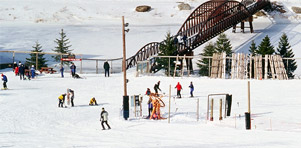Type II Skier (Intermediate)
Moderate skiing at average visual indicator settings
- Prefer a variety of speeds
- Prefer varied terrain
- Type II settings apply to skiers who do not meet all the descriptions of Type I or Type III classifications
Loon Mountain will be one of our go-to mountains, and with two convenient pick-up locations, we’ll be at Loon aboard our Urban Sherpa coaches in just two-and-a-half hours. Traverse through the mountain wilderness and experience the rush of a moose-sighting or the exhilaration of reaching the pinnacle of one of their 4,000-foot peaks. Why Loon? ’Cause it’s an awesome mountain with terrain for everyone, with more snow than ya know. Loon also has a Burton Learn-to-Ride (LTR) program, which incorporates the right equipment with proven teaching methods to make learning to board easy and fun.
New England’s newest terrain, Loon South Peak 2,450-foot summit is accessed by the Lincoln Express Quad from the base of South Peak. From the summit of South Peak, look west to Mt. Moosilauke; look north to Cannon Cliffs, Mt. Lafayette, and Franconia Notch; look down to the town of Lincoln, where one feels like one may just ski right onto Main Street.
Three options down South Peak include two groomed runs with snowmaking—Cruiser and Boom Run or the gladed trail, Undercut. Head to skier’s right for Boom Run. The wide expanse of the summit narrows at the ledges as Boom Run turns into a classic New England ski trail with twists, turns, and intermediate steeps before the run out back to the base. Head to skier’s left for Cruiser. First cut in 1996, many locals have been poaching fresh powder on this trail over the years. The terrain is wide open and this trail will have the best afternoon light.
Everybody meets up at the Crossings. Some people come to check out the great cruising trails and action-packed Loon Mountain Park, home of the Superpipe. Others join their friends to get on the gondola ride, relax at the original Octagon Lodge, or enjoy the sophisticated après-ski scene in the Bunyan Room. Grab your friends and head to the Crossings.
As the highest point at Loon, the North Peak truly makes Loon New Hampshire’s number-one ski resort. Zoom up to the top via the North Peak Express Quad, and you’ll discover the famous Walking Boss trail and other long, cruising trails packed with fresh powder and sunshine. Complete with breathtaking scenery, the North Peak is the premier skiing and riding experience.
There is no place to hide on the East Basin. Home to Loon’s steepest trails, this is where the real thrill-seekers come to get their heart racing. The East Basin allows expert skiers and riders to test their skills on old-style trails with double fall lines. So check out this secret side of Loon. We dare you.
The second-highest point at Loon, the Highlands has something for everyone. In addition to magnificent views, the Highlands is a gateway to tons of trails for any ability, including Bear Claw trail, which takes riders from the summit all the way down to the base. It is also home to the Summit Cafe, and the destination of Loon’s breathtaking gondola ride.
A day of adventure at Loon Mountain begins at Base Camp. It’s home to the ticketing area, Mountainside Rentals, and award-winning Ski and Snowboard School and Children’s Ski and Ride Discovery Camps. From beginner trails to intermediate terrain, there’s something for the whole family at the Base Camp.
A parent or legal guardian must complete and bring along a Minor Permissions Slip for each child age sixteen (16) and under.
Your bindings settings usually follow your batting stance. If you are right-handed and bat right-handed, then you will probably feel most comfortable with your left foot forward (regular). If you are left-handed or bat “lefty,” then you will likely feel right foot forward is more natural (goofy).
These are just guidelines to start. We can help you find the right fit for your ride.

Determining your ski ability is your responsibility!
Your ski ability, height, weight, age, and boot-sole length are used by the shop to determine the visual indicator settings of your ski bindings. Be sure to provide accurate information, as any error may increase your risk of injury. Consult the skier type descriptions to select your classification. These descriptions are compatible with ASTM and ISO documents.
Cautious skiing at lower visual indicator settings
Moderate skiing at average visual indicator settings
Aggressive skiing at higher visual indicator settings